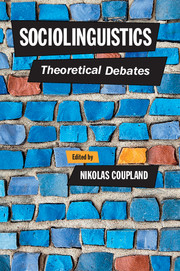Book contents
- Frontmatter
- Contents
- List of contributors
- Preface and acknowledgements
- 1 Introduction: Sociolinguistic theory and the practice of sociolinguistics
- Part I Theorising social meaning
- Part II Language, markets and materiality
- Part III Sociolinguistics, place and mobility
- 9 Mobile times, mobile terms: The trans-super-poly-metro movement
- 10 Sedentarism and nomadism in the sociolinguistics of dialect
- 11 From mobility to complexity in sociolinguistic theory and method
- Part IV Power, mediation and critical sociolinguistics
- Part V Sociolinguistics, contexts and impact
- Part VI The evolution of sociolinguistic theory
- Index
- References
11 - From mobility to complexity in sociolinguistic theory and method
from Part III - Sociolinguistics, place and mobility
Published online by Cambridge University Press: 05 June 2016
- Frontmatter
- Contents
- List of contributors
- Preface and acknowledgements
- 1 Introduction: Sociolinguistic theory and the practice of sociolinguistics
- Part I Theorising social meaning
- Part II Language, markets and materiality
- Part III Sociolinguistics, place and mobility
- 9 Mobile times, mobile terms: The trans-super-poly-metro movement
- 10 Sedentarism and nomadism in the sociolinguistics of dialect
- 11 From mobility to complexity in sociolinguistic theory and method
- Part IV Power, mediation and critical sociolinguistics
- Part V Sociolinguistics, contexts and impact
- Part VI The evolution of sociolinguistic theory
- Index
- References
Summary
Introduction
In a celebrated article, Aaron Cicourel emphasized that “it is important to locate the analysis of language and social interaction in a wide variety of social activities that are implicitly and explicitly known to the participants and the investigator” (1992: 296). The case built in that article revolved around the challenge, notably in conversation analysis and other branches of discourse analysis, to do justice to the tremendous complexity characterizing real social environments – a medical environment in Cicourel's concrete study – and the need, consequently, to employ “several types of ethnographic and textual materials in order to underscore … unavoidable aspects of organizational and local constraints and processes that are integral to rethinking ‘context’” (p. 309). If we accept, like Cicourel, that any form of human communication is set in a real social environment and draws on real and actual bodies of knowledge and experience of participants operating as “context” in social encounters, then tracing the sources of knowledge and experience of participants becomes a key issue, because “[a]s long as we continue to reify terms like ‘social structure’, ‘culture’ and ‘language’, we shall miss the contextual and cognitive significance of everyday social organization” (Cicourel 1973: 9) and we shall continue to impute our own, researchers’, assumptions and biases to the people we study.
Such reifications, of course, are a legacy of structuralism and found their way into the standard methodologies of a good deal of contemporary social and human sciences. In sociolinguistics, Glyn Williams's (1992) critique of work as widely diverse as Labovian variationism, Fishmanian sociology of language, and Schegloffian conversation analysis demonstrated the lasting and pervasive influence of structural-functionalist consensus models handed down from Talcott Parsons (drawing in turn heavily on Durkheim). Such models, Williams explained, would imagine any social environment as an integrated ‘complete’ system displaying an elementary form of equilibrium, in which every individual member would know what was expected from him or her, and in which such knowledge would be accessible to all members.
- Type
- Chapter
- Information
- SociolinguisticsTheoretical Debates, pp. 242 - 260Publisher: Cambridge University PressPrint publication year: 2016
References
- 37
- Cited by



